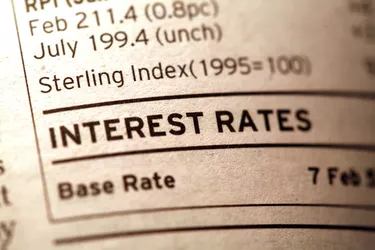
Whether you want to calculate interest earned (savings account or investment) or interest due (loan or credit card), the balance upon which interest is calculated is the key variable. To identify the balance subject to interest, you need to understand the terms of the account agreement. The account agreement will explain how interest is calculated and the date of the balance upon which interest is payable or due.
Step 1
Read and understand the account agreement for the savings or loan account. For example, since the CARD Act of 2009, credit card companies can only charge an increased interest rate on new purchases made after the disclosed rate change, not on the entire balance from prior periods. Savings account interest changes may apply to balances at month end or another specified date in the account agreement. This contract controls the balance subject to prior or new interest rates.
Video of the Day
Step 2
Examine your account statement for outstanding balance amounts at "interest dates." For example, if your credit card agreement specifies that your outstanding balance as of the 25th of a month is the amount upon which that month's interest charge is calculated, find your balance as of that date. If your card company increased the rate during the month, identify your balance before the increase and subtract it from the balance as of the 25th. This tells you the balance subject to the former interest rate and the balance (amount) subject to the new, higher rate.
Step 3
Add purchases and charges made to your ending account balance from the prior month. Subtract any payments and credits (purchase returns or deposits) you made to the account. Keep the balance "cutoff" date in mind unless your account agreement states that balances subject are those existing on the last day of the month. Disregard charges incurred or payments/credits made after the balance "cutoff" date. For example, your beginning balance is $2,100 on the first day of the month. You make the purchases of $100, $150, and $50, along with a payment of $75. Add your purchases ($300) to your starting balance, increasing your outstanding balance to $2,400. Subtract your $75 payment to calculate an outstanding balance of $2,325 subject to the monthly interest charge.
Step 4
Verify that the balance is correct. Examine purchases (or deposits/withdrawals) for accuracy to ensure that the calculated balance subject to interest charge (or payment) is accurate. While accounting departments and computers seldom make numerical errors, mistakes can still be made. Calculating your balances subject to interest charges (or payments), particularly for credit cards, eliminates potential costly errors. Your calculations should match your statement's computer balance.
Tip
Call your bank or credit card company to clarify any balance or balance date explanations that are unclear to you. New credit card regulations simplify account language, but confusion can be costly. Hand calculate interest charges (or payments) to ensure accuracy.
Warning
Take nothing for granted. Examine balances subject to interest closely as errors in amount and dating are more common than most people realize. Don't assume a single account balance date for interest calculation, as many credit card accounts calculate your "average daily balance" for the amount subject to interest charges.
Things You'll Need
Account agreement
Calculator
Calendar
Video of the Day